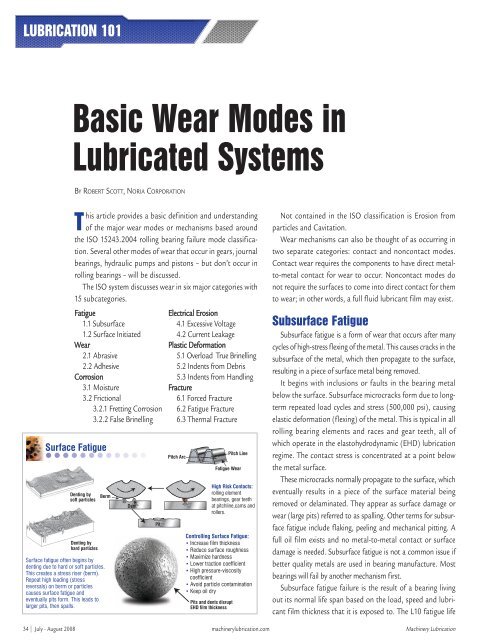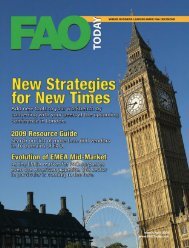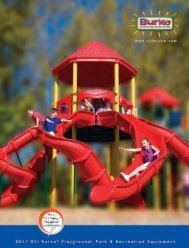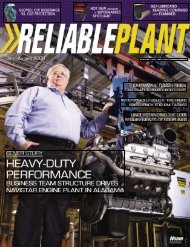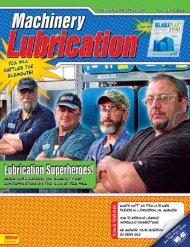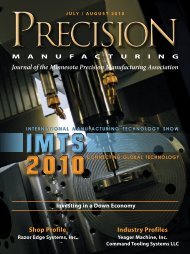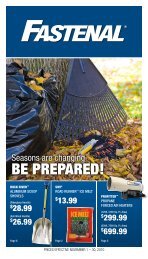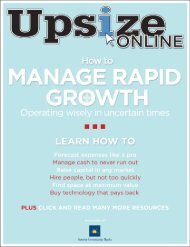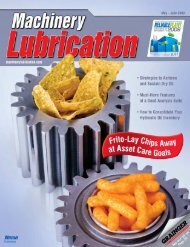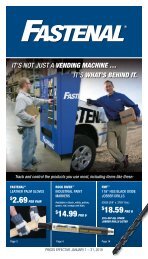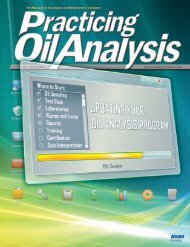Machinery Lubrication July August 2008
Machinery Lubrication July August 2008
Machinery Lubrication July August 2008
You also want an ePaper? Increase the reach of your titles
YUMPU automatically turns print PDFs into web optimized ePapers that Google loves.
LUBRICATION 101<br />
Basic Wear Modes in<br />
Lubricated Systems<br />
BY ROBERT SCOTT, NORIA CORPORATION<br />
This article provides a basic definition and understanding<br />
of the major wear modes or mechanisms based around<br />
the ISO 15243.2004 rolling bearing failure mode classification.<br />
Several other modes of wear that occur in gears, journal<br />
bearings, hydraulic pumps and pistons – but don’t occur in<br />
rolling bearings – will be discussed.<br />
The ISO system discusses wear in six major categories with<br />
15 subcategories.<br />
Surface Fatigue<br />
Denting by<br />
soft particles<br />
Denting by<br />
hard particles<br />
Berm<br />
Surface fatigue often begins by<br />
denting due to hard or soft particles.<br />
This creates a stress riser (berm).<br />
Repeat high loading (stress<br />
reversals) on berm or particles<br />
causes surface fatigue and<br />
eventually pits form. This leads to<br />
larger pits, then spalls.<br />
Fatigue<br />
1.1 Subsurface<br />
1.2 Surface Initiated<br />
Wear<br />
2.1 Abrasive<br />
2.2 Adhesive<br />
Corrosion<br />
3.1 Moisture<br />
3.2 Frictional<br />
3.2.1 Fretting Corrosion<br />
3.2.2 False Brinelling<br />
Dent<br />
Pit<br />
Electrical Erosion<br />
4.1 Excessive Voltage<br />
4.2 Current Leakage<br />
Plastic Deformation<br />
5.1 Overload True Brinelling<br />
5.2 Indents from Debris<br />
5.3 Indents from Handling<br />
Fracture<br />
6.1 Forced Fracture<br />
6.2 Fatigue Fracture<br />
6.3 Thermal Fracture<br />
Pitch Arc<br />
Pitch Line<br />
Fatigue Wear<br />
High Risk Contacts:<br />
rolling element<br />
bearings, gear teeth<br />
at pitchline,cams and<br />
rollers.<br />
Controlling Surface Fatigue:<br />
• Increase film thickness<br />
• Reduce surface roughness<br />
• Maximize hardness<br />
• Lower traction coefficient<br />
• High pressure-viscosity<br />
coefficient<br />
• Avoid particle contamination<br />
• Keep oil dry<br />
Pits and dents disrupt<br />
EHD film thickness<br />
Not contained in the ISO classification is Erosion from<br />
particles and Cavitation.<br />
Wear mechanisms can also be thought of as occurring in<br />
two separate categories: contact and noncontact modes.<br />
Contact wear requires the components to have direct metalto-metal<br />
contact for wear to occur. Noncontact modes do<br />
not require the surfaces to come into direct contact for them<br />
to wear; in other words, a full fluid lubricant film may exist.<br />
Subsurface Fatigue<br />
Subsurface fatigue is a form of wear that occurs after many<br />
cycles of high-stress flexing of the metal. This causes cracks in the<br />
subsurface of the metal, which then propagate to the surface,<br />
resulting in a piece of surface metal being removed.<br />
It begins with inclusions or faults in the bearing metal<br />
below the surface. Subsurface microcracks form due to longterm<br />
repeated load cycles and stress (500,000 psi), causing<br />
elastic deformation (flexing) of the metal. This is typical in all<br />
rolling bearing elements and races and gear teeth, all of<br />
which operate in the elastohydrodynamic (EHD) lubrication<br />
regime. The contact stress is concentrated at a point below<br />
the metal surface.<br />
These microcracks normally propagate to the surface, which<br />
eventually results in a piece of the surface material being<br />
removed or delaminated. They appear as surface damage or<br />
wear (large pits) referred to as spalling. Other terms for subsurface<br />
fatigue include flaking, peeling and mechanical pitting. A<br />
full oil film exists and no metal-to-metal contact or surface<br />
damage is needed. Subsurface fatigue is not a common issue if<br />
better quality metals are used in bearing manufacture. Most<br />
bearings will fail by another mechanism first.<br />
Subsurface fatigue failure is the result of a bearing living<br />
out its normal life span based on the load, speed and lubricant<br />
film thickness that it is exposed to. The L10 fatigue life<br />
34 <strong>July</strong> - <strong>August</strong> <strong>2008</strong> machinerylubrication.com <strong>Machinery</strong> <strong>Lubrication</strong>


